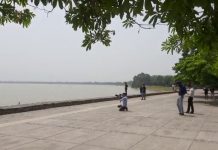Jakarta, December 23: A tsunami killed at least 168 people and injured 745 on the Indonesian islands of Java and Sumatra following an underwater landslide caused by the eruption of Anak Krakatau, a spokesperson for the disaster mitigation agency told media on Sunday.
Hundreds of homes and other buildings were “heavily damaged” in the tsunami which struck along the rim of the Sunda Strait late on Saturday.
It was the latest in a series of tragedies that have struck Indonesia, a vast archipelago, this year. Successive earthquakes flattened parts of the tourist island of Lombok, and a double quake-and-tsunami killed thousands on Sulawesi island. Nearly 200 people died when a Lion Air passenger plane crashed into the Java Sea in October.
Authorities warned residents and tourists in coastal areas around the Sunda Strait to stay away from beaches and a high-tide warning remained in place through till December 25.
“Please do not be around the beaches around the Sunda Strait. Those who have evacuated, please do not return yet,” said Rahmat Triyono, an official at the Meteorology, Climatology and Geophysics Agency (BMKG).
TV footage showed roads blocked by debris from damaged houses, overturned cars and fallen trees. The water washed away an outdoor stage where a local rock band was performing, killing at least one musician. Others were missing.
On December 26 in 2004, an Indian Ocean tsunami triggered by an earthquake killed 2,26,000 people in 13 countries, including more than 1,20,000 in Indonesia. The eruption of Krakatau in 1883 killed more than 36,000 people in a series of tsunamis.
Endan Permana, head of the disaster mitigation agency in Pandeglang, told Metro TV police were providing assistance to victims in Tanjung Lesung in Banten province, a popular tourist getaway not far from the capital, Jakarta, as emergency workers had not arrived.
The western coast of Banten province in Java was the worst-hit area so far, said Sutopo Purwo Nugroho, spokesman for the national disaster mitigation agency.
At least seven people were reported dead in Lampung in southern Sumatra.
Rescue workers and ambulances were finding it difficult to reach affected areas because some roads were blocked by debris, said Ketut Sukerta, head of the disaster agency in South Lampung.
‘Washed away’
Around 250 employees of the state utility company PLN had gathered in Tanjung Lesung for an end-of-year event, company spokesman I Made Suprateka told Reuters. At least seven people were killed and many suffered broken bones, he said.
Dramatic TV footage showed the seconds when waves hit a concert at the event and washed away the stage where local rock band Seventeen was performing.
“The water washed away the stage which was located very close to the sea,” the band said in a statement. “The water rose and dragged away everyone at the location. We have lost loved ones, including our bassist and manager…and others are missing.”
The disaster mitigation agency said it was still compiling information on the disaster and there was a “possibility that data on the victims and damage will increase”.
The tsunami was caused by “an undersea landslide resulting from volcanic activity on Anak Krakatau” and was exacerbated by abnormally high tide because of the full moon, disaster agency spokesman Nugroho said.
Ben van der Pluijm, an earthquake geologist and a professor in the University of Michigan, said the tsunami may have been caused by a “partial collapse” of Anak Krakatau.
“Instability of the slope of an active volcano can create a rock slide that moves a large volume of water, creating local tsunami waves that can be very powerful. This is like suddenly dropping a bag of sand in a tub filled with water,” he said.
Anak Krakatau, an active volcano which is located roughly halfway between Java and Sumatra and has been spewing ash and lava for months, erupted again just after 9 p.m. on Saturday and the tsunami struck at around 9.30 p.m., according to BMKG.
Anak Krakatau is the island that emerged from an area once occupied by Krakatau, which was completely destroyed in the 1883 disaster. It first appeared in 1927 and has been growing ever since.
Coastal residents reported not seeing or feeling any warning signs, like receding water or an earthquake, before waves of up to two meters washed ashore, according to media.
https://twitter.com/MaestroDEPR/status/1076646570370785280
Nugroho told Metro TV that tsunamis triggered by volcanic eruptions were “rare” and that the Sunda Strait tsunami had not resulted from an earthquake.
“There was no earthquake, and the Anak Krakatau eruption also wasn’t that big,” Nugroho told Metro TV, noting there were no “significant” seismic tremors to indicate a tsunami was coming.
The eruption created a column of volcanic ash up to 500 metres high. Reuters






































